Traditional Turkish food is the continuation of Ottoman Empire cuisine. The Ottomans fused Central Asian, Middle Eastern, Mediterranean, Eastern European, and Balkan cuisines to create one of the world’s most diverse and influential cuisines.
Kebabs and dishes made with lamb figure prominently in Turkish food, but the cuisine varies by region. The western coast is famous for its many olive oil-based dishes. Central Anatolia for its hearty pastries, and the cities and towns by the Black Sea for their abundance of fresh fish.
TURKISH BREAKFAST
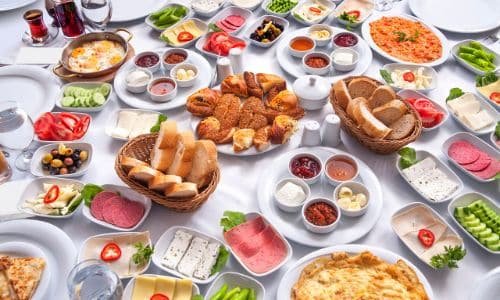
Menemen
Menemen is a traditional Turkish breakfast dish of scrambled eggs with olive oil, tomatoes, green peppers, and spices. It’s similar to shakshouka – a popular Maghrebi dish commonly eaten in North African countries like Tunisia, Egypt, and Morocco.
You can also eat it with onion though this is a point of contention in Turkey. Some people prefer it with onions, and add onions when eating it for breakfast.
Katmer
Katmer refers to a tasty Turkish pastry dish originally from Gaziantep. It’s a type of sweet börek with crispy phyllo dough, pistachios, melted butter, and clotted cream. Though katmer can also be eaten for dessert, Gaziantep locals prefer to consume it for breakfast. They believe that the pistachios in the dish increase energy levels and help reduce morning fatigue.
Katmer also plays a symbolic role in Turkish weddings. Traditionally, the father of the groom sends katmer to the newlyweds and to the bride’s parents the morning after the wedding. It signifies his wishes for them to have a sweet marriage and to recover quickly after a tiring ceremony.
TURKISH BREAD
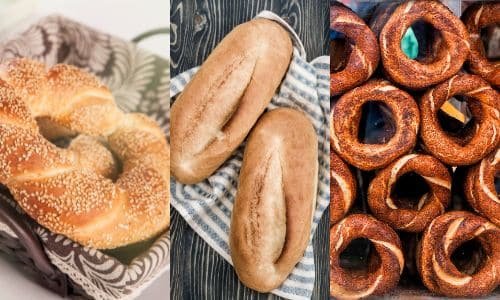
Simit
Simit is one of the most popular Turkish foods. You’ll find it sold from these red street food carts everywhere in the city. Simit refers to a type of bagel-like Turkish bread encrusted with seeds. It commonly is with sesame seeds though it is also covered with poppy, flax, or sunflower seeds. It’s a crunchy and chewy snack that is eatable on its own or as part of a larger Turkish breakfast with fruit preserves, cheese, and traditional Turkish tea.
Acma
If simit sounds appealing to you, then you’ll definitely want to try Acma as well. It refers to another ring-shaped Turkish bread covered with sesame, cumin, or nigella seeds. Softer in texture than simit, covered with beaten egg yolks before baking, and often enjoyable for breakfast with hot Turkish tea.
Bazlama
Bazlama is a type of soft, leavened Turkish flatbread. Also known as “village bread”, it’s traditionally cooked on a heavy pan over an open wood fire. It’s similar to naan bread but thicker and heavier, sort of like a big crumpet. It is mostly for breakfast with butter or olive oil or you can add various ingredients like fresh vegetables and cheese and eat it like a sandwich.
TURKISH SNACKS / APPETIZERS / PASTRIES

Leblebi
Leblebi is a Turkish street food snack that contains roasted chickpeas. You can eat it plain or seasoned with salt, hot spices, and dried cloves. In some cases, they are candy-coated. Leblebi is a popular snack in Turkey and in other countries throughout the Middle East like Iran, Syria, Lebanon, and Afghanistan.
Pide
Pide refers to a type of boat-shaped Turkish flatbread that’s baked in a brick or stone oven. Sometimes referred to as Turkish pizza, topped with any number of ingredients like cheese, onion, pepper, tomato, sucuk (spicy Turkish sausage), and egg. Pide is considered an important component of Turkish cuisine and you can find it everywhere, from sit-down restaurants to street food carts.
Lahmacun
Although it looks like a thin cheese-less pizza, it’s actually a type of flatbread/wrap topped with a variety of different ingredients like minced meat (commonly lamb or beef), vegetables, pickles, herbs, onions, tomatoes, and spices.
To eat, you roll up the lahmacun with vegetables like pickles, peppers, tomatoes, onions, lettuce, and roasted eggplant. It’s crisp around the edges and chewy towards the center, like a pizza. When done well, it’s incredibly delicious. Lahmacun is equally popular in Armenia where it’s known as lamadjo.
Börek
Börek refers to a family of stuffed pastries popular in Ottoman cuisine. Made with a thin flaky dough like phyllo or yufka, it exists in many forms and contains different ingredients like meat, cheese, potatoes, and vegetables. It is baked or in some versions fried.
Like lahmacun, börek was one of our favorite Turkish foods. It comes in many regional varieties like water börek, pen börek, rose börek, and palace börek. Börek is popular in many countries throughout the Balkans, the Caucasus, and North Africa like Croatia, Armenia, Bosnia and Herzegovina, Albania, and Tunisia.
TURKISH SANDWICHES / WRAPS FOODS

Dürüm
Dürüm means “roll” and refers to Turkish wraps with lavash or yufka bread commonly filled with doner meat. It’s one of the most popular types of Turkish street food and is pretty much anywhere. These doner kebab vertical rotisseries are ubiquitous in Turkey. Seasoned meat (typically lamb, beef, or chicken) is stacked in the shape of an inverted cone and turned slowly next to a vertical heating element. When cooked, the outermost layer shaves off in thin pieces and serve on a plate or wrapped in a dürüm.
The doner kebab is one of the most important and influential dishes in Turkish cuisine. It’s an inspiration by similar dishes like Greek gyros, Arab shawarmas, and Mexican tacos al pastor.
Islak Burger
The unattractive islak burger represents Turkish drunk food at its ugliest and most delicious. Meaning “wet burger”, these soggy and greasy orange-tinged burgers are dunked in a garlicky tomato sauce before being left to steam in a hamam-style glass box, hence the name.
Islak burgers are moisty, chewy, and garlicky. They don’t look all that appetizing but they’re oddly delicious, especially after you’ve had a few beers. It’s impossible to eat just one. Kizilkayalar in Taksim Square is one of the most popular places to have islak burgers in Istanbul. A favorite among late-night boozers, featuring on the Istanbul episode of No Reservations.
Balik Ekmek
Balik ekmek translates to “fish bread”, which describes exactly what it is — a Turkish fish sandwich. It consists of a grilled mackerel fillet sandwiched in a bun with onions, lettuce, tomatoes, and a spritz of lemon. Balik ekmek is a sandwich enjoyable by the ocean.
TURKISH MEAT / SEAFOOD FOODS
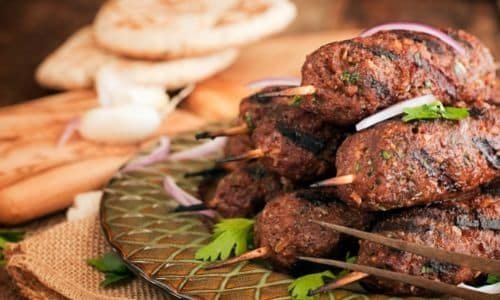
Kofte
Kofte refers to a family of meatball or meatloaf dishes popular in many countries throughout Central Asia, India, the Balkans, and the Middle East. In its simplest form, it’s made with minced or ground meat (typically beef, lamb, or chicken) mixed with onions, herbs, and spices.
Kofte is an important dish in Turkish cuisine. You can find almost 300 varieties of kofte in Turkey, some of the most well-known being kuru kofte (dry), sulu kofte (soup), cig kofte (raw), and sis kofte (skewered).
Testi Kebap
which was the most interesting Turkish dish we had in Cappadocia. Also called pottery kebab is an Anatolian specialty prepared in a clay pot or jug. It’s usually made with lamb, beef, or chicken mixed with vegetables, potatoes, and garlic.
The ingredients are placed in the pot and sealed with bread dough before being left to cook in their own juices for several hours in a tandoor or clay oven. When ready, the jug is brought out and cracked open at your table. If you were to have just one Turkish dish in Cappadocia, then it should definitely be testi kebap.
Hunkar Begendi
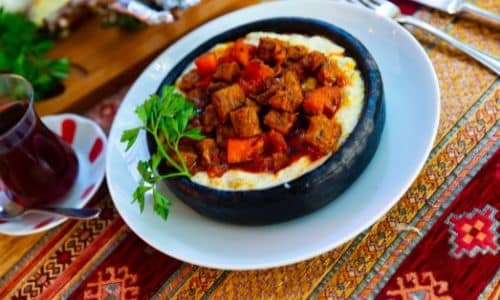
Hunkar begendi refers to a type of Turkish lamb stew made with meltingly tender pieces of lamb leg served over an eggplant bechamel sauce. Commonly known as “Sultan’s Delight”, it’s a delicious meat dish with an interesting backstory.
Hunkar begendi literally means “Sultan liked it” or “Sultan pleasing”. Its creation used to be in the kitchens of Dolmabahce Palace for the French Empress Eugenie, who came to Istanbul to visit Sultan Abdülaziz. The common misconception is that the Sultan enjoyed the dish, hence the name, it was actually Empress Eugenie who liked it.
Fresh Fish
Four seas surround Turkey so it is a coastal area and is famous for its abundance of seafood. Lamb figures prominently in Turkish cuisine but so does fresh fish.
People visiting Istanbul will have plenty of seafood restaurants to choose from. It’s surrounded (and divided) by water so you’ll often find many types of fish being offered at different times of the year.
If you go on a Bosphorus cruise, then you can enjoy seafood dishes at one of the many seaside restaurants in Anadolu Kavagi. It’s the last stop on the cruise and where most tourists get off to have lunch or dinner.
TURKISH VEGETARIAN / VEGETABLE FOODS
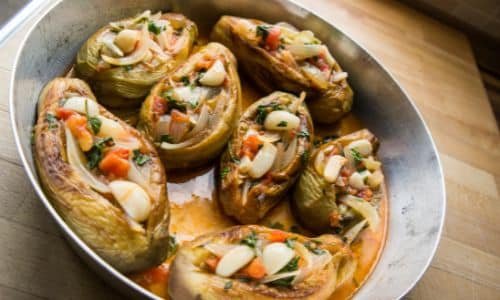
Imam Bayildi
Imam Bayildi refers to a whole eggplant full of onion, garlic, and tomato and then simmered in olive oil. It’s served at room temperature and often made with a good-sized eggplant so it’s substantial enough for eating as an entree.
Interestingly, imam bayildi literally means “imam (Islamic leader) fainted”. There are several theories as to how it got its name, one of the most humorous beings that the imam fainted after learning of the cost of the ingredients and the amount of olive oil used to make this traditional Turkish dish. When made with minced meat like ground lamb or ground beef, imam bayildi becomes known as karniyarik.
Kisir
Kisir refers to a Turkish bulgur salad made with finely ground bulgur, parsley, tomato sauce, and other ingredients like onions, garlic, olive oil, lemon, juice, and spices. You can think of it as the Turkish version of Lebanese tabbouleh or Armenian.
Ezogelin Çorbası
Ezogelin çorbası is one of the most popular Turkish foods. It refers to a hearty soup made with bulgur and red lentils as its main ingredients. The recipe for ezogelin soup is from a woman whose name is Ezo Gelin who lived in the village of Uruş in Gaziantep. They often prepare it at home and serve it at many Turkish restaurants throughout the country.
Cig Kofte
The sale of authentic çiğ köfte — the kind made with actual raw meat — has been banned since 2009 as a health precaution. Most commercially available çiğ köfte is now without meat, mostly with bulgur as a substitute.
However, Çiğ köfte was one of the most interesting dishes we had in Turkey. It’s a Turkish raw meat dish with either beef or lamb commonly served cold as a meze or in a dürüm. In its traditional form, çiğ köfte is made with finely ground fatless raw beef kneaded into a thick mixture with bulgur. And a host of other ingredients like onions, tomatoes, fresh mint, parsley, and spices.
TURKISH DESSERTS
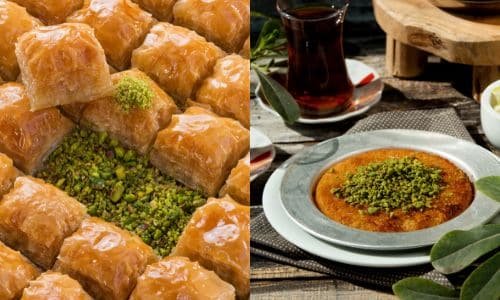
Kunefe
This was one of the best desserts we’ve ever had. Kunefe refers to a crisp cheese-filled dessert made with shredded kadayif dough soaked in sweet syrup and topped with clotted cream. It’s a traditional Middle Eastern dessert that’s popular in Turkey, Greece, the Balkans, and the South Caucasus region. When served piping hot from the oven, the cheese comes away in these stretchy gooey strings.
Baklava
I’ve always wondered where baklava comes from and it’s interesting to learn that it may have its origins in Turkish Ottoman cuisine. According to this article, its current form may differ from the imperial kitchens of Topkapi Palace.
Baklava is a rich and sweet pastry made with layers of phyllo dough filled with chopped nuts and held together with syrup or honey. It’s popular in Turkey and in many other countries in Central Asia, the Middle East, the Balkans, the South Caucasus, and Egypt.
Turkish Delight (Lokum)
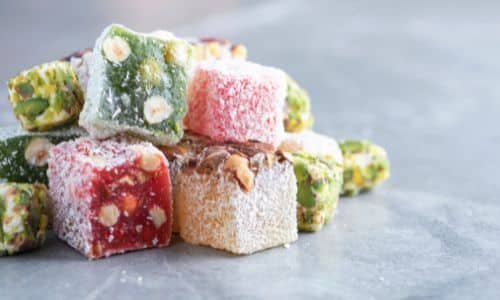
Turkish delight or lokum refers to a family of gelatinous confections commonly enhanced with different flavorings. We can name rosewater, mastic, bergamot orange, or lemon. It’s an iconic dessert or candy in Turkish cuisine that’s typically cut and eaten in small cubes dusted with powdered sugar to prevent clinging.
Premium varieties have other ingredients bound to the gel like chopped dates, pistachios, hazelnuts, and walnuts. Lokum is one of the most popular Turkish souvenir food and you can find it at many shops and markets.
Dondurma
Dondurma is Turkish ice cream. It’s a sticky type of ice cream that contains salep (ground-up orchid tubers) and mastic (plant resin) which makes it chewier in texture and more resistant to melting. Dondurma’s origin is in the city of Maraş hence the alternate name is Maraş ice cream.
Source: willflyforfood.net



